Estée Lauder
Continued onto: Estée Lauder (post 1960)
Like those other grande dames of beauty, Elizabeth Arden and Helena Rubinstein, Estée Lauder was very evasive when it came to discussing her origins and early life. When she heard that Lee Israel was going to publish an unauthorised biography, ‘Estée Lauder. Beyond the magic’ (1985) she rushed to print her own version “to set the record straight” (Lauder, 1985, p. 11). However, her book ‘Estée. A success story’ continued her previous pattern of mixing facts and half truths with fiction.
Origins
Estée was born Josephine Esther Mentzer at 9 Hillside Avenue in Corona, Queens, a largely Italian working-class neighbourhood in New York. Her parents, Rose Mentzer (née Schotz) and Maximilian Mentzer were Jewish immigrants from Hungary. Their union produced two children, Estée and her older sister Grace Rhea ‘Renee’ Mentzer [1906-1988] who joined the five surviving children from Rose’s previous marriage to Abraham Rosenthal.
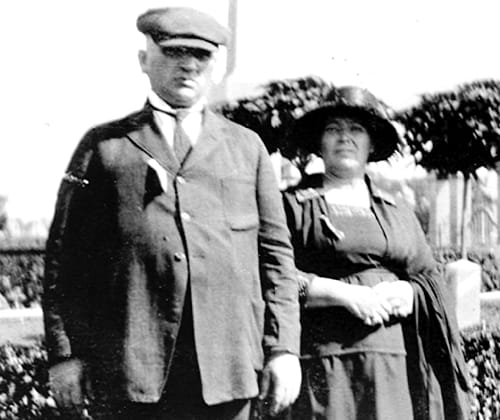
Above: Max Mentzer [c.1878-1962] and Rose Mentzer [c.1872-1957]. Estée places this photograph at her father’s cemetery property. The land in Paramus, New Jersey and been bought in conjunction with a number of Jewish families, later becoming the Beth-El Cemetery (Israel, 1985, p. 15). Max become its manager later in his life.
The family stories that Estée details in her book appear to be selected to cast her in the best light. Her siblings get almost no mention, apart from Renee’s contraction of polio, and her parents’ backgrounds are glamourised. Her mother is described as “discreet, elegant, and deeply committed to family” (Lauder, 1985, p. 8), her father “a Czechoslovakian horseman, an elegant dapper monarchist” who “bought a hardware store on Corona Avenue with savings he bought from Europe” (Lauder, 1985, p. 13). More attention is given to her mother’s younger brother, John M. Schotz [1887-1964]. She credits him with sparking her interest in cosmetics but leaves out or invents significant parts of the story.
Uncle John Schotz. Charming, erudite, inquiring, my mother’s brother came to visit us from Hungary. He was a skin specialist. What glories those words contour up!
On the heels of Uncle John’s arrival came a terrible war in Europe. I was too young to understand its implications, but I did understand that because of its horror, Uncle John had to stay in America. Secretly, I rejoiced.
He captured my imagination and interest as no one else ever had. I was smitten with Uncle John. He understood me. What’s more, he produced miracles. I watched as he created a secret formula, a magic cream potion with which he filled vials and jars and flagons and any other handy container. It was a precious velvety cream, this potion, one that magically made you sweetly scented, made your face feel like spun silk, made any passing imperfection gone by evening.(Lauder, 1985, pp. 17-18)
In other versions of this story, Estée claims that Schotz was from Vienna not Hungary and came to New York for the World’s Fair. The World’s Fair opened just before the Second not the First World War as she frequently claimed. However, as Schotz arrived in America in 1900 this point is mute.
Schotz was a chemist not the skin specialist or dermatologist Estée describes. In 1925, when Estée was sixteen and still at high school, he was living with his wife Flora Anna Schotz (née Greenstein) [1892-1966] in the house of his mother-in-law and two of his wife’s siblings. By then he had established New Way Laboratories on West 43rd Street, New York and it is there that Estée appears to have been introduced to the manufacturing side of cosmetics.
New Way Laboratories
New Way Laboratories made a wide range of products ranging from poultry remedies through to cosmetics and toiletries. Most of the cosmetics it produced were sold under the Flory Anna or Florana label, both names being references to Schotz’s wife.
Lee Israel suggests that New Way Laboratories was established in 1924. However, there is a 1923 advertisement for the firm, and the Florana trademark also lists 1923 as the first year of use. By 1930, the company had also changed its name to Neway Laboratories and was advertising its services as a private label manufacturer.
Estée’s claim that her uncle constructed a laboratory cosmetics in Queens seems to have been invented to suggest that she was personally experimenting with cosmetics from an early age. This allows her promote her skill as a formulator and distances her cosmetics from those produced by her uncle.
We constructed a laboratory of sorts in the tiny stable behind the house. My parents installed gleaming linoleum on the floors and walls. We set up a table, where I watched my uncle mix his magic.
Do you know what it means for a young girl to suddenly have someone take her dreams quite seriously? Teach her secrets?
I could think of nothing else. After school, I’d run home to practice being a scientist. I began to value myself with so much more, trust my instincts, trust my uniqueness.(Lauder, 1985, p. 19)
Given that her uncle was the source of her inspiration it might be thought that Estée would try help him and his wife when they fell on hard times. This does not appear to have been the case.
Estée’s business activities between 1925 and 1945 get largely overlooked in her autobiography but Israel suggest that she travelled between New York and Florida making sales wherever she could. Elderly Jewish women probably made up a significant part of her clientele. Life on the road would have been tough, particularly through the years of the Great Depression but this is when she learnt the business of selling. Her ability to keep going despite the difficulties is admirable – she was determined to succeed.
Estée does document some of her personal life during this time. Her marriage to Joseph Lauter [1902-1983] (1930) and the birth of their first child, Leonard Allan Lauter (1933) is covered as is her divorce from Joseph (1939), their reconciliation (1943), and the birth of their second son, Ronald Steven Lauder (1944). After they reconciled Joseph took control of the manufacturing side of the business while Estée went on the road to drum up sales.
Estée recollections of the years when she was a ‘free woman’ are also very selective. She mentions that she struck up a number of friendships with men between 1939 and 1943 but does not divulge her possible romance with Arnold Louis van Ameringen. He would become extremely important to her company in the following decades.
Arnold Louis van Ameringen
Like Estée, van Ameringen was Jewish. He came in New York in 1917 as a representative for Polak & Schwarz, a Dutch essential oil and perfume materials company. After deciding to settle in America he set up his own business in New York (1918). The business incorporated (1927) and established a laboratory and manufacturing facilities (1928) before merging with Morana, Inc. (1929). The newly merged firm, van Ameringen-Haebler, Inc., became a major supplier of raw materials and fragrances for a wide variety of perfume, soap, cosmetic and toiletry companies. It did a lot of business with Estée Lauder over the years, either as van Ameringen-Haebler or as International Flavors & Fragrances, Inc. (IFF), the company formed when van Ameringen-Haebler merged with Polak & Schwarz in 1958.
The exact nature of van Ameringen’s assistance to Estée Lauder’s fledgling company is unknown but Estée puts the development of Estoderme Youth-Dew Creme down to Dr. Jerry Amsterdam, described by Estée as her chief chemist (Lauder, 1985, p. 74). What she fails to mention is that this refers to Herman J. Amsterdam [1905-1966] who was then working for van Ameringen-Haebler as its director of products research. Another van Ameringen-Haebler employee, Ernest Shiftan [1903-1976], is believed to have formulated Youth-Dew, the bath oil that put Estée Lauder firmly on its feet. One can only speculate on other product developments Estée Lauder outsourced to van Ameringen during its early years. It is possible that Lauder relied on van Ameringen for many of its new formulations through to the establishment of Estée Lauder’s research and development laboratory in 1967.
Beginnings
Exactly when Estelle Lauter became Estée Lauder is difficult to pin down. The family is still listed as Lauter in the 1950 census but Israel states that Estée had listed herself as Estée Lauder in the 1937 New York telephone directory (Israel, 1985, p. 24). She also notes that there is no listing for Joseph in the 1937 directory which suggests they had separated by then. It is possible that Estée took on the name Lauder to distinguish herself from Joseph after they parted. I have not been able to track down the 1937 directory entry but do have a record from the 1940 Manhattan directory (issued in 1939) where she is listed as both Estelle and Estee Lauder.

Above: Entries from the 1940 Manhatten Telephone directory.
Equally hard to pin down are Estée business activities in the years immediately before the Estée Lauder Cosmetic Company was founded in 1946. In her autobiography, she mentions having concessions in two hairdressing establishments, ‘The House of Ash Blondes’ and Albert and Carter. The House of Ash Blondes was actually the Florence Morris Salon at 39 East 60th Street occasionally advertised as ‘The Home of Ash Blondes’. Morris started life as an actress but had developed a range of hair dyes sold under the La Playa trademark.
The Estée Lauder range sold through these concessions was extremely limited. Estée only mentions four skin-care products – Cleansing Oil, Creme Pack, Super Rich All-Purpose Creme, and Skin Lotion – but Leonard Lauder says his mother also sold an eye cream in the 1930s (Lauder, 2020, p. 25).
Cleansing Oil: “[A] deep pore cleanser.”
Creme Pack: “[T]o lift and firm the skin, to stimulate circulation.”
Super Rich All-Purpose Creme: “[A] cleanser, lubricant, night cream, conditioner and foundation in one.”
Skin Lotion: “[A] gentle astringent, delightfully cool and refreshing.”
Estée packaged her skin-creams in medicinal-looking, white opal-glass jars with black lids and stick-on labels. The only record I have for how these might have looked is an advertisement published by Leonard Lauder that he claims is from the early 1940s.
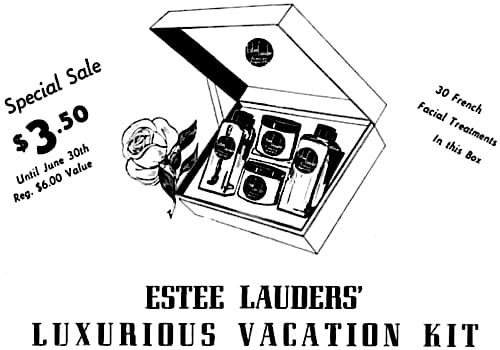
Above: Estée Lauder Vacation Kit.
Lauder combined her four skin-care products into a simple facial routine. Unusually, the Creme Pack was included in this routine rather than being used as a stand-alone face mask. If my information is correct, it contained unbleached clay so would have acted as an oil absorber and exfoliant.
1. Cleansing Oil first. Deep, softening,
2. Next, 5 minutes of Creme Pack. Tautening effect.
3. Then smooth on Super-Rich All-Purpose Cream. For that soft baby-glow.
4. Follow with tingling Skin Lotion—the china smooth touch.(Estée Lauder advertisement, 1950)
In 1947, Estée managed to get a counter in Saks Fifth Avenue. By then, her skin creams had been repackaged in containers manufactured by T. C. Wheaton Co., Millville, New Jersey, painted in a shade later known as Estée Lauder Blue.
Published orders made out to Albert A. Katz of Philadelphia (1946) and Sak Fifth Avenue (1947) show that there was more to Estée Lauder than four skin creams. Her early range also included face powder, lipstick, and eyeshadow as well as a cream and dry rouge. Estée claims that her lipstick, eyeshadow and cream rouge only came in one shade, Duchess Red for the lipstick, Turquoise for the eye shadow, and a cream rouge that would ‘harmonize with all complexions’ possibly called Glow. If this is the case the limited range did not last very long. By 1951, the Duchess Lipsticks also came in at least two other shades Duchess Coral and Duchess Melon. Further shades were added to Estée Lauder lipsticks, eyeshadows and rouges through the 1950s. Unfortunately, the information I have about these new additions is very limited.
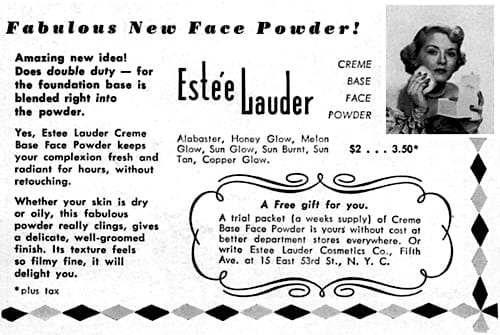
Above:1951 Estée Lauder Cream Base Face Powder.
The Creme Base Face Powder may also have only debuted in a single shade, Honey Glow, but was being produced in seven shades by 1951 – Alabaster, Honey Glow, Melon Glow, Sun Glow, Sun Burnt, Sun Tan, and Copper Glow. It was sold in a basic square powder box which was given a lift-up lid by 1956 making it very similar to one used by Elizabeth Arden for her Illusion Powder. Estée may have taken other things from Arden, such as Arden’s idea of combining two lipstick colours to contour the lips, and using light and dark face powder shades together to contour the face.
See also: Elizabeth Arden (1930-1945)
From its description, Creme Base Face Powder appears to have been a cold cream powder. These powders contained a small amount of fat or oil which helped them stick to the skin so were sometimes known as fat powders or fettpuders. They were best suited for women with a dry skin type.
Creme Base Face Powder: “[H]as the foundation base blended right into it. Its one-coat coverage gives a sheerer, more natural finish. A truly fabulous face powder. It can be applied to oily or troubled skin overnight as a corrective treatment.”
See also: Fettpuders (Fat Powders)
In addition to the previously mentioned Super-Rich Eye Creme, Lauder was also selling Hand and Arm Creme by 1949 and Special Throat Creme by 1951.
Super-Rich Eye Creme: “The rich consistency penetrates into wrinkles, smooths away that dried-out look, helps to firm the skin.”
Hand and Arm Creme: “[E]xtra rich. Massage hands and arms liberally and often to protect against dryness.”
Special Throat Creme: “To help prevent your neck from aging prematurely.”
There were other early Lauder products that I know little or nothing about. The image below taken in Neiman Marcus in Dallas in 1951 includes a block/cake mascara – Lauder recommended the Navy-Blue shade – and a number of products in the walled glass cabinets that I have been unable to identify.
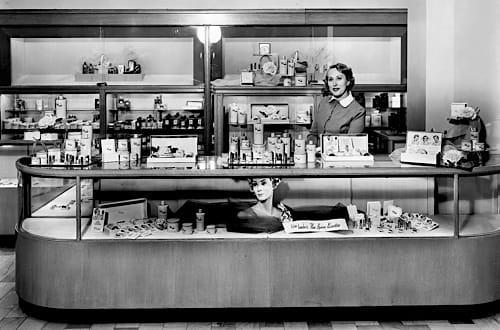
Above: 1951 Estée Lauder behind the counter at Neiman Marcus in Dallas, Texas.
Department Stores
By 1951, Estée Lauder was available in a number of department and specialty stores. Examples include: Saks Fifth Avenue in New York; Bonwit Teller in Boston, Chicago and Philadelphia; Neiman Marcus in Dallas; Regensteins in Atlanta; Scruggs, Vanderwort & Barney in St. Louis; and I. Magnin in San Francisco.
As Leonard Lauder noted, department stores were the key to Estée Lauder’s success. In the days before the arrival of credit cards like Visa and Mastercard and charge cards like American Express, high-end department stores like Saks offered select customers cards that enabled them to charge in-store purchases to their account. This meant they could buy Estée Lauder cosmetics on impulse even if they were low on cash.
More importantly, addresses from these charge cards enabled department stores to create mailing lists. Estée managed to convince stores to use these to send customers a card that could be exchanged for a free gift at an Estée Lauder counter. The initial resistance from department stores was soon overcome when they realised that the offer of a free gift brought women to the store who might then go off and make purchases in other departments.
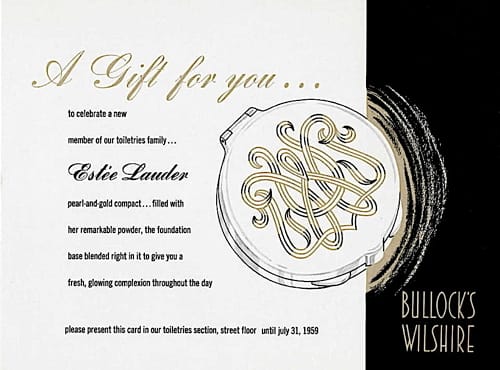
Above: 1959 One side of an Estée Lauder gift card distributed by Bullock’s Wilshire.
The free gifts would later become ‘Gift-with-Purchase’. Estée Lauder was not the first cosmetic company to give away free cosmetics or to offer a free gift with purchase but no one used it more effectively.
Youth-Dew
Estée Lauder’s first important addition to her range was Estoderme Youth-Dew Creme (1951) developed by Herman J. Amsterdam as previously mentioned. The name was a good choice as it suggested Estée, skin, youth, and moisture. Used as a night cream or as a base for make-up, the cream contained whole eggs along with ingredients that were supposed to act like hormones but were not. Others had added eggs to cosmetics well before this, Elizabeth Arden’s Venetian Anti-Wrinkle Cream (1921) being a good example.
Estoderme Youth-Dew Creme: “[I]ncludes the whole egg in its formula, reinforced with Vitamin A and D among its moisture-restoring ingredients . . . to give your complexion a lovely dewy freshness! A make-up foundation by day . . . a miracle-working overnight cream.”
See also: Elizabeth Arden (1920-1930)
Vitamins A and D had been used in cosmetics back in the 1930s so their inclusion was nothing new. Also, care must be taken when reading too much into the phrase ‘moisture-restoring ingredients’. The modern concept of moisturisation had not been developed in 1951 and adding moisture to the skin generally meant adding oil until the late 1950s.
See also: Vitamin Creams, Dry Skin Treatments and Moisturisers
In 1952, Estée Lauder expanded the range with Estoderme Youth-Dew Flowing Emulsion adding Estoderme Youth-Dew Liquid Concentrate a few years later. The use of ‘flowing’ may have been selected to resonate the product with Jacqueline Cochran’s very successful Flowing Velvet Lotion (1949).
Estoderme Youth-Dew Flowing Emulsion: “A rich, light moisturiser and powder base in one to help soothe away lines and wrinkles.”
Estoderme Youth-Dew Concentrate: “A facial preparation so highly concentrated a few drops daily helps lift, firm and tone.”
In 1953, Estée Lauder added Estoderme Youth-Dew Bath Oil to the Estoderme range. It was initially promoted as a skin restorative and the Estoderme part of the name was only dropped after the bath oil became popular.
Estoderme Youth-Dew Bath Oil: “[C]ontains the moisture-restoring emollients derived from whole egg, plus a new, specially blended perfume.”
Originally given away as a gift with purchase, the success of the fragrance was probably as big a surprise to Estée Lauder as it was to her competitors. Its popularity had lasting consequences on the company’s revenues, brand recognition, and market power and has been widely credited with setting Estée Lauder on a firm foundation.
Estée Lauder claimed that the scent was a modification of a fragrance originally developed by her uncle, improved by her through months of experimentation.
There was a scent I’d been exposed to for years. My uncle had created it for a Russian princess and my mother always had it around the house. It wasn’t exactly right, though . . . not exactly.
(Lauder, 1985, p. 78)
However, as mentioned earlier, most authorities suggest that Youth-Dew was created by Ernest Shiftan, the chief perfumer at van Ameringen-Haebler although Estée Lauder may have played a role in the final selection of the fragrance.
Youth-Dew was not the first perfumed bath oil introduced into the American market. Examples include Abano Bath Oil (1932), a strong, dark bath oil introduced by Prince Matchabelli, and Parfums Weil Secret de Venus (1946), another dark bath oil that came in Zibeline, Cassandra, and Antilope fragrances. It seems likely that much of Youth-Dew’s success was due to it initially being given away. This allowed women to try it and then come back and purchase more.
Estée Lauder quickly capitalised on the popularity of the bath oil adding a range of other Youth-Dew products during the 1950s. These included toiletries such as Youth-Dew Soap, Cool Spray Bath Powder, Lotion de Sachet, Dusting Powder, Skin Perfume, and Eau de Parfum Spray. Body Satinée, an after-bath body lotion fragranced with Youth-Dew was added in 1958. A built-in dispenser was added to the bottle in 1965.
Body Satinée: “Simply apply it after your tub when the skin is most receptive and it soothes and smoothes rough patches on arms, crinkled elbows and chapped legs.”
The Youth-Dew range also extended to Youth-Dew Translucent Face Powder (1956), Youth-Dew Translucent Powder Base (1957), and Sun Creme (1958) by which time the range accounted for 80% of Estée Lauder’s sales.
In 1954, Estée Lauder also added Youth Dew to her Creme Base Face Powder to create a compact powder in six shades. Originally sold in a golden plastic mock-tortoiseshell case with a gold monogram; later compacts came in blue and pearl shades.
Youth-Dew Creme Based Face Powder Compact: “Indispensable for keeping your skin young looking, soft and glowing the day long, it reveals a translucent quality of youthful freshness and natural beauty never before attained.”
Youth-Dew Translucent Face Powder: “This powder is blended to give a wholly new effect, a pearly translucent gleam. A single application gives complete coverage, stays on and on because it contains Youth-Dew. Known shades: Transparent, Honey Glow, Porcelain, Alabaster, Sun Burnt, Sun Glow, and Copper Glow.
Youth-Dew Translucent Powder Base: “Contains the fabulous Youth Dew—for that youthful glow. Creates an almost iridescent appearance. Excellent for dry skin, it helps to give you a fresh, lasting translucent complexion. Flows on so easily—just a few drops give a day-long finish make-up.” Shades: Alabaster, Porcelain, Honey Glow, Sun Glow, Sun Burnt, and Copper Glow.
Sun Creme: “[F]or an immediate tan. Contains Youth-Dew for a smooth, glowing bronze.”
Teen Beauty
In 1956, Estée Lauder developed a liquid cleanser, powder compact, and two shades of lipstick – Teen Pink and Teen Coral – for the teenage market.
Teen Beauty Cleanser: “[A] wonderfully thinner-than-water tight liquid that not only floats off every trace of dirt and grime, but goes deep into the pores to remove any oily accumulations and impurities . . . all one application.”
Teen Powder Compact: “[A] fine pressed powder that protects the skin without clogging the pores.”
In her autobiography, Estée Lauder admitted this was a mistake. Her market was mainly mature women, and the range was quickly abandoned.
Another mistake was trying to reach the teenage market. Teen cleanser, teen this, teen that. Teens were simply not our image, even though teens can surely benefit from our products.
(Lauder, 1985, p. 165)
It would be over a decade before Estée Lauder would actively try to engage a younger market once more when it introduced Clinique in 1968.
Re-Nutriv
The company had more success with Re-Nutriv, the ‘creme of creams’, also introduced in 1956. The name suggested the cream was nutritional without specifically claiming that it was so, thus getting around the Wheeler-Lea and Food, Drug, and Cosmetic Acts of 1938. Estée makes no mention of who formulated it in her autobiography but it is possible that it was also developed by van Ameringen-Haebler.
See also: The FDA, FTC and Cosmetics
Advertising for Re-Nutriv stated that it contained 25 ingredients but only five of them were actively promoted – Turtle Oil, Shark Oil, Royal Jelly, Silicone, and Leichol. Despite being used to justify the US$115.00 price tag for the largest 22-karat gold-plated 16 oz. jar, none of these ingredients were rare or costly. However, America was in the middle of a craze for cosmetics with miracle biological ingredients so this was a case of ‘if one is good then more must be better’.
Miracle cosmetic ingredients, like miracle drugs, are being discovered faster than you can pronounce their names. Usually they appear one-at-a-time in a cosmetic potion and you are torn between royal jelly and vitamins, super-lubricants and super-moisturizers. Now, Estee Lauder has combined, in one cream, the most, beneficial of these cosmetic miracle workers: turtle oil for lubrication, shark oil for Vitamin A, silicone to retain skin moisture and the new leichol, that helps rebuild tissues. All these are whipped up into a golden jar and labeled Re-Nutriv.
(Estée Lauder advertisement, 1956)
Estée Lauder had also used at least one of them before, including turtle oil in her Super-Rich All Purpose Cream.
In 1958, Estée Lauder added Liquid Re-Nutriv that could be used under make-up as a daytime companion to Creme Re-Nutriv and Re-Nutriv Lipsticks.
Creme Re-Nutriv: “[W]ith its wealth of rare and costly ingredients, was formulated to renew the healthy complexion of youth. This ‘Creme of Cremes’ was created to give the skin the youthful bloom, radiance and freshness that women have been seeking for years.“
Liquid Re-Nutriv: “[T]he merest bit under your make-up enriches your skin with the same rare and costly ingredients, and brings to it a radiance and freshness you may have forgotten you own.”
Make-up
Developments in Estée Lauder make-up through to 1960 are difficult to track down as the company did very little product advertising outside of that done in conjunction with department stores until 1960.
Eye make-up
Estée Lauder was selling a cake/block mascara and an eyeshadow in the early 1950s but had very little else on offer until 1959 when the company added Estée Lauder Liquid Eyeliner, Eye Shadow Stick and Roll-O-Matic Mascara, the last item being an automatic mascara similar to the one introduced by Helena Rubinstein in 1957. Like Rubinstein’s Mascara-Matic, it was applied with a grooved rod rather than a brush but the applicator came with a comb on the other end of the rod which suggests it was made by Scoville.

Above: Estée Laude Roll-O-Matic Mascara in original case.
See also: Automatic Mascara
Liquid Eye Liner with brush: “It dries in seconds to a featherweight, satiny finish that lasts all day, won’t smudge, streak or melt.” Known shades: Pearl White, Aqua, Turquoise, Auburn, Iridescent Blue, Iridescent Green, Iridescent Brown, and Iridescent Black.
Roll-O-Matic Mascara: “It’s smear-proof, waterproof and won’t cake.” Known shades: Black, Brown, Jade Green, and Blue Royal.
Shadow Stick: Known shades: Turquoise, Violet, Green, Blue Royale, Roman Gold, Spanish Silver, Iridescent Blue, Iridescent Green, and Iridescent Lilac.
Deluxe Eyebrow Pencil: Known shades: Auburn, Black, Blue, Green, Gray, White, Light Brown, and Dark Brown.
Lipsticks
Most of the new American lipsticks that debuted in the early 1950s were indelibles, a tend started by the introduction of Hazel Bishop’s Lasting Lipstick, an indelible, in 1950.
Estée Lauder’s Duchess lipsticks which first appeared before 1950 do not appear to have been indelible. However, they may have been reformulated in 1953 to make them more tenacious. Lauder also expanded its shade range through to 1956 with new colours including Duchess Orange, Duchess Violet, and Duchess Pastel, as well as Dancing Red, Dancing Pink, and Dancing Pastel.
In 1954, Estée Lauder also introduced its first Lip Gloss, although only in a single shade.
Lip Gloss: “[A] rose cream to be applied over your lipstick. It gives a lasting gleam that will not run or look greasy.”
Estée Lauder’s Color-Locked Lipsticks (1956) look to have been indelibles with some shades also coming as iridescents. They were followed by a Lip liner (1959) in a deep pink and red shades, and the previously mentioned Re-Nutriv Lipsticks (1958), a lipstick of the creamy type that came to predominate the American lipstick market by the end of the decade.
Leonard Lauder claims to have relaunched Re-Nutriv Lipsticks in 1959 and given it chisel-shaped rather than bullet tips, an innovation he said he invented.
I designed a new and better lipstick shape. At the time, lipsticks were bullet-shaped, so that a woman had to purse her lips around the stick to apply the color, which often left lipstick on her teeth or smeared her lip line. One day, I took a Gillette Blue Blade razor and sliced off the top of the stick at an angle, so that a woman could lay the flat side against her lip and use the tip to outline the shape of her mouth. I didn’t even think to trademark it; I just did it. And now it’s the industry standard.
(Lauder, 2020, p. 130)
However, lots of other people had this idea and there are numerous examples of chisel-topped lipsticks appearing on the market well before 1959.
See also: Lipsticks
Re-Nutriv Lipsticks were housed in ‘click in’ refillable cases so most likely used the ‘click out, click in’ quick-change cases used by Revlon, Helena Rubinstein and others from 1955.
Color-Locked lipstick: “[N]ew formula lipstick that stays on for hours without changing, protects lips against roughness and drying, won’t smear or fade away! Shades: Serene Rose, Red Rose, Blush Rose, Tea Rose, and Cherry Rose.
Re-Nutriv Lipstick: “[A] daylong beauty treatment, moisturizing the lips and preventing lining and dryness.” Shades (1959): Capri Pink, Porto Fino Rose, Madrid Ruby, Roman Red, Sevilla Red, and Florentine Cherry, with Valencia Coral, and Riviera Blush added later in the year.
Re-Nutriv Lipsticks were last new lipsticks produced by Estée Lauder during the 1950s, a decade noted for the American lipstick wars. During this time Charles Revson [1906-1975] of Revlon was focused on fighting off competition from Hazel Bishop, Coty and other established players. This meant he left Estée Lauder in relative peace, a state of affairs that would not last much longer.
See also: American Lipstick Wars
Leonard Lauder
In 1958, Leonard Lauder was discharged from the navy and came to work for Estée Lauder full time. The years following his arrival would see the company professionalise, diversify and become the international brand it is today, something acknowledged by Estée Lauder in her autobiography.
Things have certainly changed. Between then and now. Leonard established a sales force where none existed, created our first research and development laboratory, where none had existed, brought in professional management on every level, and made Estée Lauder a company of international repute.
(Lauder, 1985, p. 99)
Leonard Lauder’s role would continued to grow. He became its chief executive officer between 1982 and 1999 and its president from 1972 until 1995. When the company went public in 1995 he was made company chairman.
Timeline
| 1946 | Estée Lauder Cosmetic company founded in New York. New Products: Cleansing Oil; Crème Pack; Skin Lotion; and Super-Rich All Purpose Creme. |
| 1951 | New Products: Estoderme Youth-Dew Creme. |
| 1952 | New Products: Estoderme Youth-Dew Flowing Emulsion. |
| 1953 | New Products: Estoderme Youth-Dew Bath Oil; and Travel Trick Cream. |
| 1954 | New Products: Lip Gloss. |
| 1956 | New Products: Re-Nutriv; Youth-Dew Translucent Face Powder; Teen Beauty Cleanser; and Teen Powder Compact. |
| 1957 | New Products: Youth-Dew Translucent Powder Base. |
| 1958 | Fragrance Products Corporation founded in New York. Estée Lauder products available in Canada. New Products: Liquid Re-Nutriv; Re-Nutriv Lipsticks; Body Satinée; and Sun Creme. |
| 1959 | New York headquarters moved to 666 Fifth Avenue. New Products: Lip Liner; Liquid Eyeliner; Shadow Stick; Roll-O-Matic Mascara; and Cool Spray Bath Powder. |
Continued onto: Estée Lauder (post 1960)
First Posted: 20th September 2023
Sources
Israel, L. (1985). Estée Lauder. Beyond the magic. London: Arlington Books.
Koehn, N. F. (2001). Brand new: How entrepreneurs earned consumers’ trust from Wedgewood to Dell. Boston: Harvard Business School Press.
Koehn, N. F. (2001). Estée Lauder: Self definition and the modern cosmetics market. In P. Scranton (Ed.), Beauty and business: Commerce, gender and culture in modern America (pp. 217 -251). New York: Routledge.
Lauder, E. (1985). Estée. A success story. New York: Random House.
Lauder, L. A. (2020). The company I keep. My life in beauty. New York: Harper Business.
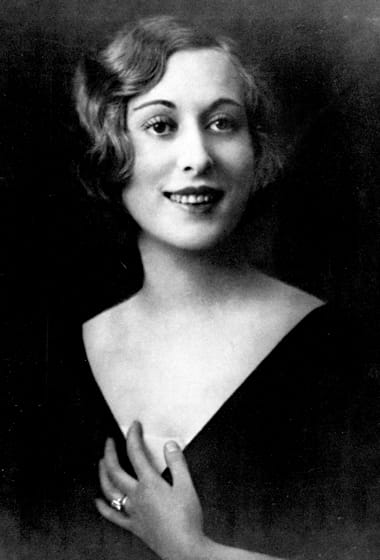
Estée Lauder (née Mentzer) [1908-2004] a.k.a. Josephine Esther Mentzer, Esther Lauter, Estelle Lauter, and Estelle Lauder.
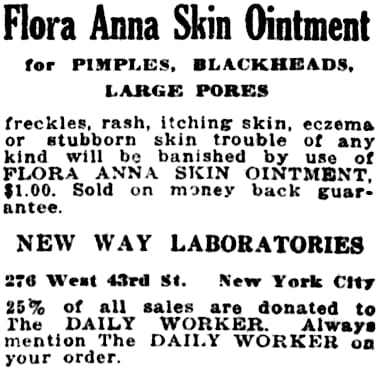
1927 Flora Anna Skin Ointment.
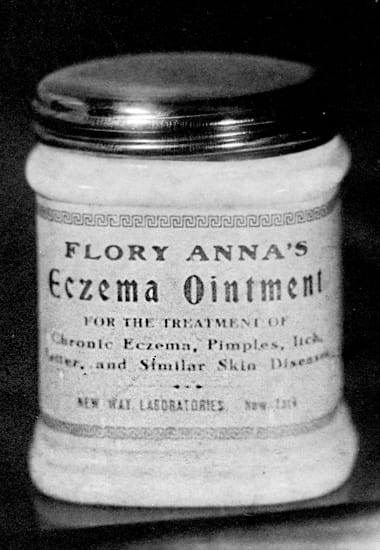
New Way Flory Anna Eczema Ointment.

Neway Laboratories as a private provider.

Joseph and Estelle Lauter in New York.
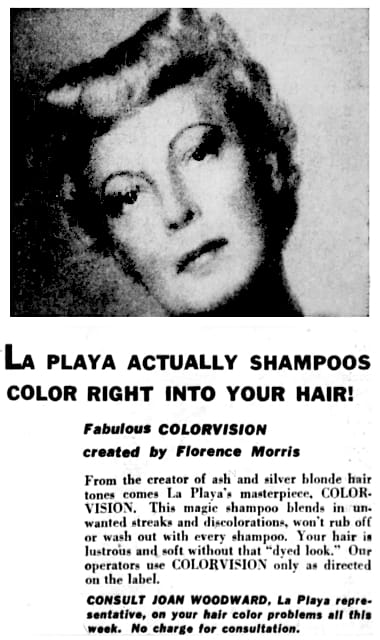
1949 Florence Morris.
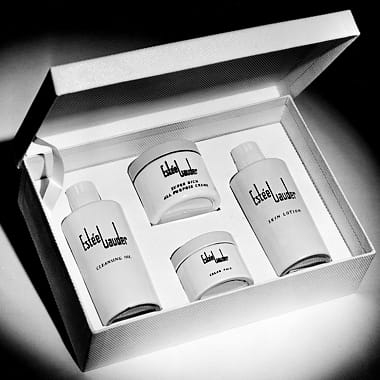
Estée Lauder Cleansing Oil, Super-Rich All-Purpose Cream, Cream Pack, and Skin Lotion.
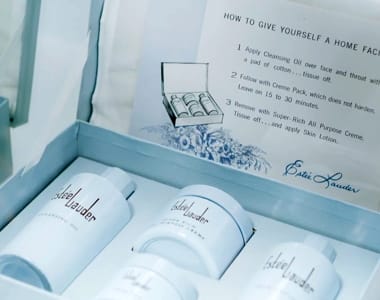
Estée Lauder Home Facial Kit. Some of the containers are made from clear glass painted blue.
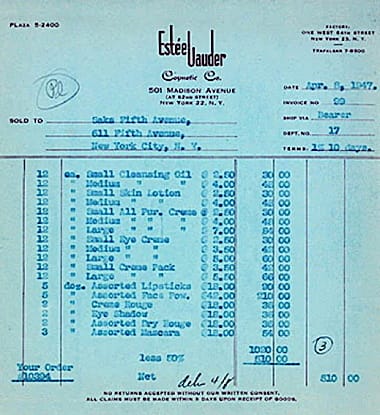
1947 Estée Lauder first invoice to Sak Fifth Avenue for US$810 after a 50% discount.
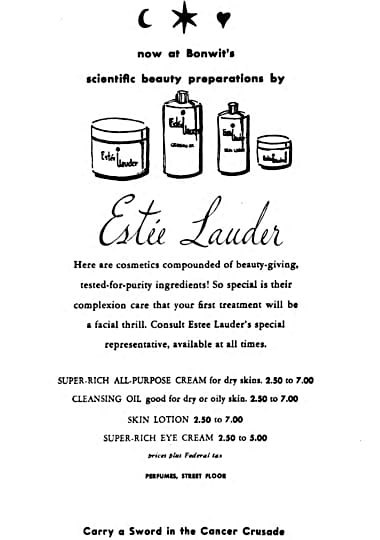
1948 Estée Lauder Super-Rich All-Purpose Cream, Cleansing Oil, Skin Lotion, and Super-Rich Eye Cream.
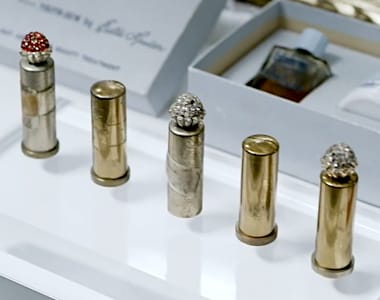
Estée Lauder Duchess Lipsticks.
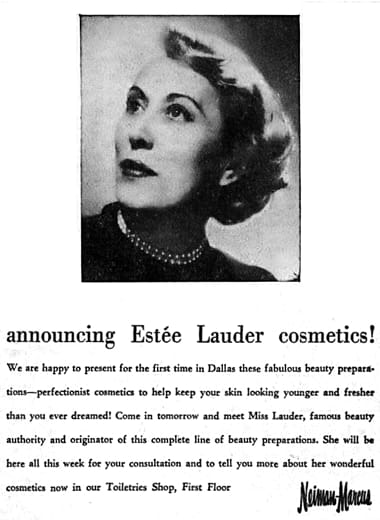
1950 Estée Lauder opening at Neiman-Marcus.
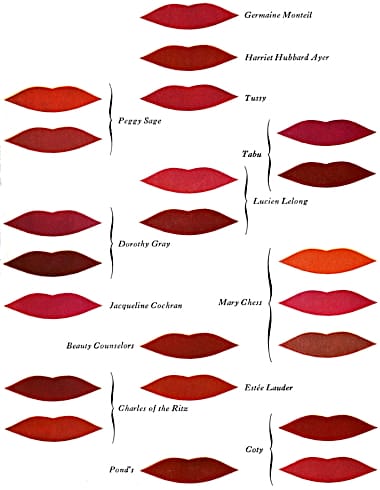
1951 Assorted lipstick shades including Estée Lauder Duchess Coral.
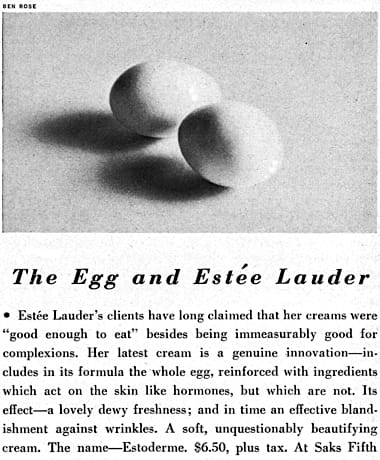
1951 Estée Lauder Estoderme.
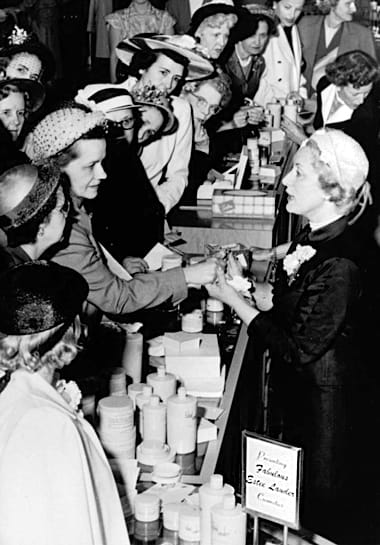
1951 Estée Lauder making an appearance at the Sakowitz department store in Houston, Texas.
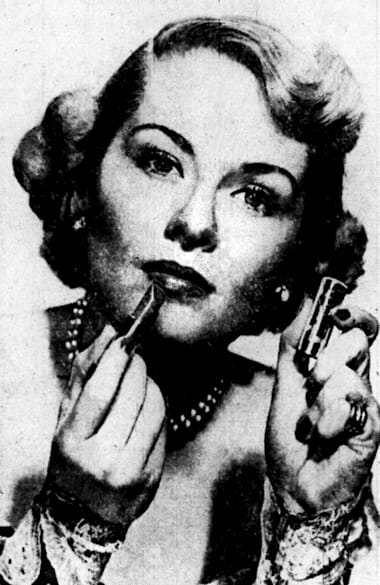
1952 Estée Lauder Dancing Red or Pink Lipstick.
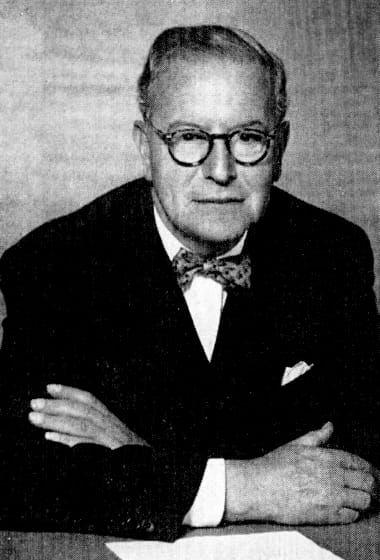
Arnold Louis van Ameringen [1891-1966].
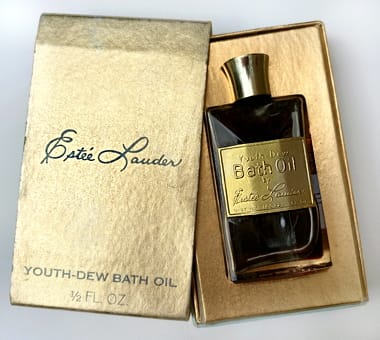
Estée Lauder Youth-Dew Bath Oil.
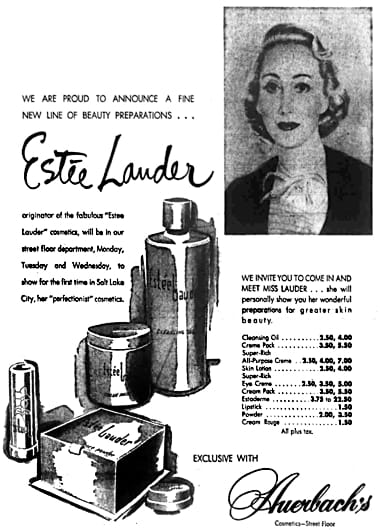
1953 Estée Lauder at Auerbachs Department Store, Salt Lake City, Utah.
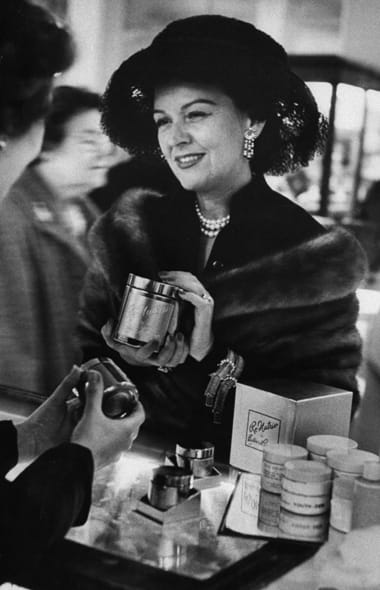
1956 Woman with Estée Lauder Re-Nutriv (LIFE).
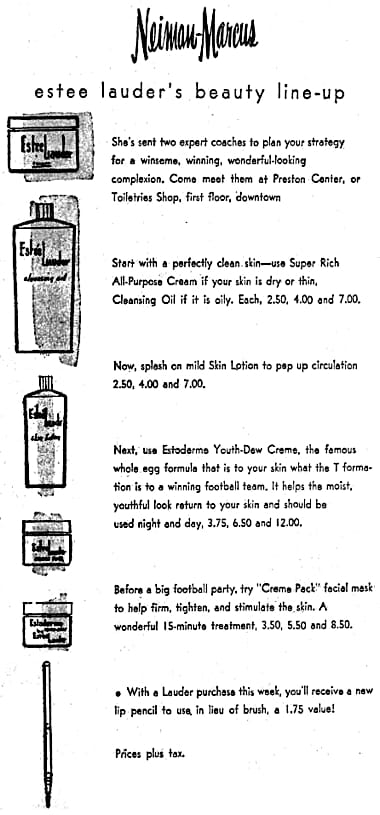
1957 Estée Lauder at Neiman-Marcus.
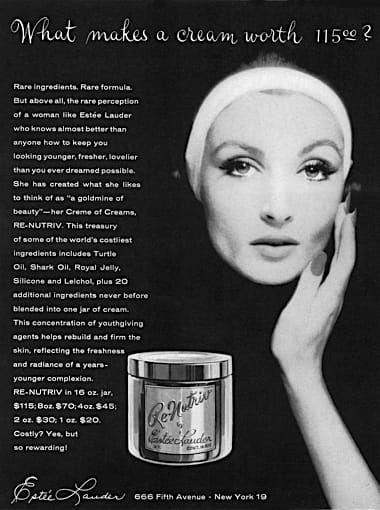
1959 Estée Lauder Re-Nutriv Creme.
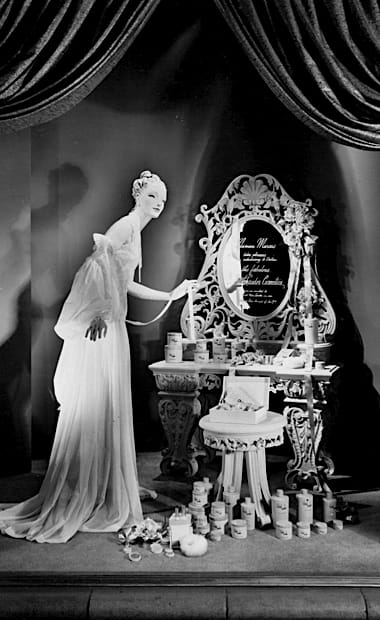
Estée Lauder window display at Neiman-Marcus.
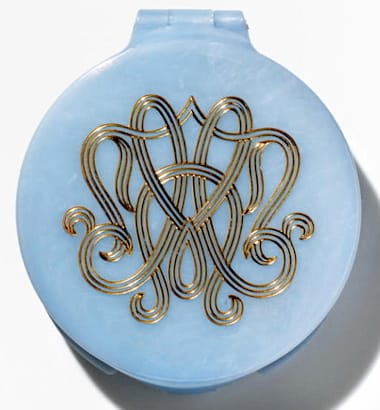
c.1959 Estée Lauder Powder Compact.

1960 Estée Lauder Cleansing Oil.
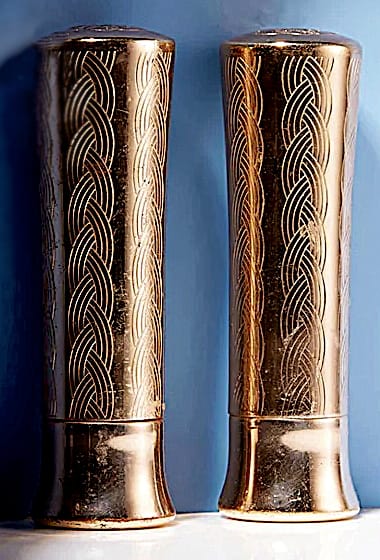
Estée Lauder Re-Nutriv Lipsticks.

1960 Estée Lauder Eye Creme.
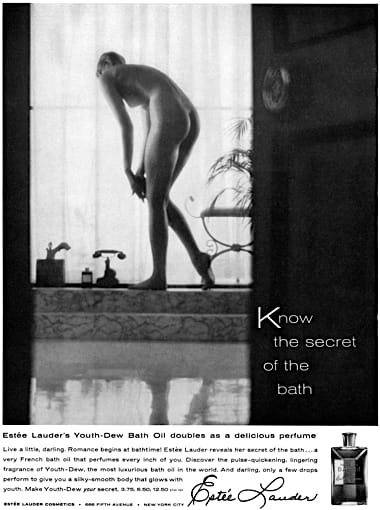
1960 Estée Lauder Youth-Dew Bath Oil.
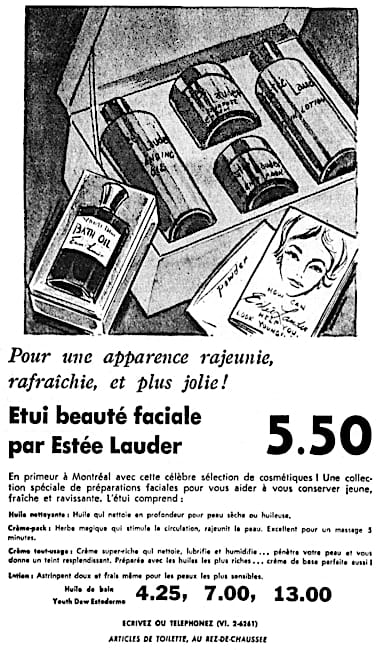
1960 Part of an advertisment for the Morgan’s Department Store in Montreal, Canada promoting Estée Lauder.
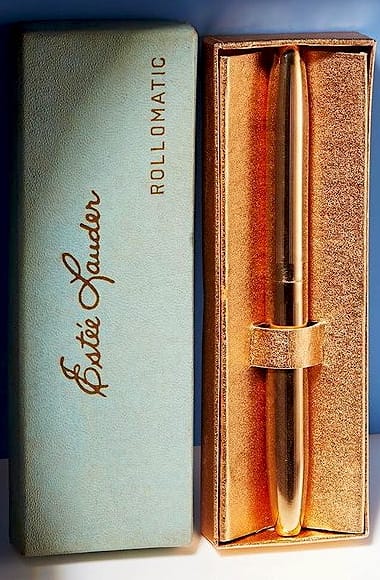
Estée Lauder Roll-O-Matic Mascara in later casing.
